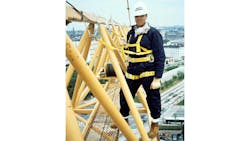The Occupational Safety and Health Act requires employers to protect their employees from recognized hazards that may result in death or serious physical harm and to comply with OSHA standards. So which standards impact workplace fall protection?
OSHA requires employers in general industry to first address safeguards to the physical structures and devices within the workplace, and then use personal protective equipment (PPE) for employees when they are unable to completely control the hazards through engineering or administrative methods.
Fall protection standards for physical structures are located under the "walking and working surfaces" standards [29 CFR 1910, Subpart D]. These standards cover floor and wall openings/holes, elevated platforms, fixed stairs and fixed ladders. For each work surface, OSHA has established minimum construction requirements for safeguards such as railings, handrails and toe boards. The goals of these standards are to minimize:
- Employee falls, and
- Objects falling on employees from surfaces above their heads.
General Fall Protection Rules
As a general rule, openings and platforms 4 feet or more above floor-level or fixed stairs with four or more risers must be constructed with railings and/or hand rails. The walking and working surfaces standards provide these specific instructions regarding the construction of these structures.
Toe boards must be installed on platforms and around openings whenever:
- Workers or visitors can pass beneath the platform, or
- The platform is above moving machinery, or
- There is equipment below the platform with which falling materials could create a hazard.
Also, open-sided floors and platforms require railings and toe boards – even if the elevation is under 4 feet – if they are above or adjacent to hazardous locations (e.g., dangerous equipment).
Unconventional Elevated Work Surfaces
Because there are many unconventional elevated working surfaces (i.e., conveyors, tops of machinery and other structures not normally considered "walking and working" surfaces), OSHA clarifies what it means by "platforms" at STD 1-1.13. According to this directive, OSHA considers something a platform, and therefore subject to the platform guarding standards, if employees will work on it on a "predictable and regular basis."
"Predictable and regular" covers functions such as, but not limited to, inspections, service, repair and maintenance that are performed at least once every 2 weeks or for a total of 4 man-hours during any sequential 4-week period. For instance, if two employees work for 2 hours each (4 man-hours total) within a 4-week period, that elevated surface would be considered a "platform."
Personal Protection Equipment
As a general rule, PPE must be provided, used and maintained in reliable conditions whenever hazards in the workplace can cause injury or impairment from physical contact [29 CFR 1910.132(a)]. If, after securing the workplace by installing mandatory safeguards, employees still are at risk from falling hazards, then employers must select, provide and train their employees in the proper use and care of their personal protective equipment.
The safety and health regulations for general industry do not have standards for specific fall protection PPE. However, there are specifications for certain fall prevention and fall arrest systems within the safety and health regulations for construction [29 CFR 1926). While these regulations may not directly apply to non-construction-related practices, they may serve as a basis for demonstrating the general requirements at 29 CFR 1910.132. In addition, there may be consensus standards that pertain to a workplace scenario that may provide assistance to the employer in assuring that fall protection PPE has been evaluated and implemented properly under the general industry regulations.
About the author: Joel Gregier is an instructor team leader and course developer for Lion Technology in Lafayette, N.J., a source for hazmat shipping, hazardous waste management, and workplace health and safety training since 1977. Gregier is lead instructor for the Preparing for OSHA’s New GHS Rule webinar, presented throughout 2013 at Lion.com.
